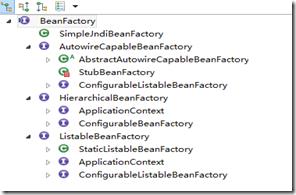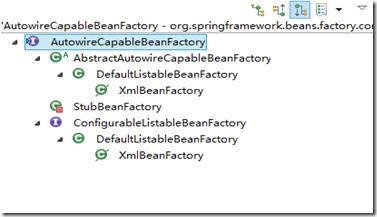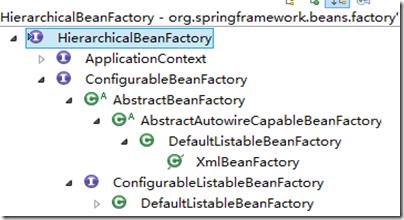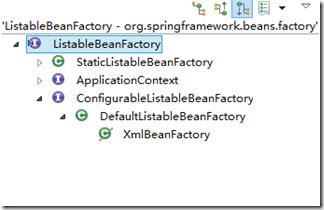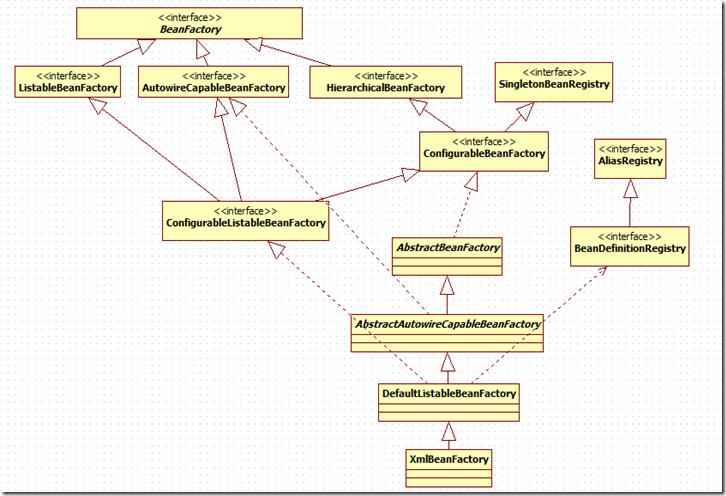Spring源码学习之BeanFactory体系结构
Posted
tags:
篇首语:本文由小常识网(cha138.com)小编为大家整理,主要介绍了Spring源码学习之BeanFactory体系结构相关的知识,希望对你有一定的参考价值。
一.BeanFactory
BeanFactory是Spring IOC容器的鼻祖,是IOC容器的基础接口,所有的容器都是从它这里继承实现而来。可见其地位。BeanFactory提供了最基本的IOC容器的功能,即所有的容器至少需要实现的标准。
BeanFactory体系结构是典型的工厂方法模式,即什么样的工厂生产什么样的产品。BeanFactory是最基本的抽象工厂,而其他的IOC容器只不过是具体的工厂,对应着各自的Bean定义方法。但同时,其他容器也针对具体场景不同,进行了扩充,提供具体的服务。
二.BeanFacory源码
1.java doc
首先是Java doc,现在阅读源码的习惯是一定要理解了java doc的描述,因为这里是作者的描述,没有人比作者更明白这个类,这个接口要干什么。
/** * The root interface for accessing a Spring bean container. * This is the basic client view of a bean container; * further interfaces such as {@link ListableBeanFactory} and * {@link org.springframework.beans.factory.config.ConfigurableBeanFactory} * are available for specific purposes. * * <p>This interface is implemented by objects that hold a number of bean definitions, * each uniquely identified by a String name. Depending on the bean definition, * the factory will return either an independent instance of a contained object * (the Prototype design pattern), or a single shared instance (a superior * alternative to the Singleton design pattern, in which the instance is a * singleton in the scope of the factory). Which type of instance will be returned * depends on the bean factory configuration: the API is the same. Since Spring * 2.0, further scopes are available depending on the concrete application * context (e.g. "request" and "session" scopes in a web environment). * * <p>The point of this approach is that the BeanFactory is a central registry * of application components, and centralizes configuration of application * components (no more do individual objects need to read properties files, * for example). See chapters 4 and 11 of "Expert One-on-One J2EE Design and * Development" for a discussion of the benefits of this approach. * * <p>Note that it is generally better to rely on Dependency Injection * ("push" configuration) to configure application objects through setters * or constructors, rather than use any form of "pull" configuration like a * BeanFactory lookup. Spring‘s Dependency Injection functionality is * implemented using this BeanFactory interface and its subinterfaces. * * <p>Normally a BeanFactory will load bean definitions stored in a configuration * source (such as an XML document), and use the {@code org.springframework.beans} * package to configure the beans. However, an implementation could simply return * Java objects it creates as necessary directly in Java code. There are no * constraints on how the definitions could be stored: LDAP, RDBMS, XML, * properties file, etc. Implementations are encouraged to support references * amongst beans (Dependency Injection). * * <p>In contrast to the methods in {@link ListableBeanFactory}, all of the * operations in this interface will also check parent factories if this is a * {@link HierarchicalBeanFactory}. If a bean is not found in this factory instance, * the immediate parent factory will be asked. Beans in this factory instance * are supposed to override beans of the same name in any parent factory. * * <p>Bean factory implementations should support the standard bean lifecycle interfaces * as far as possible. The full set of initialization methods and their standard order is:<br> * 1. BeanNameAware‘s {@code setBeanName}<br> * 2. BeanClassLoaderAware‘s {@code setBeanClassLoader}<br> * 3. BeanFactoryAware‘s {@code setBeanFactory}<br> * 4. ResourceLoaderAware‘s {@code setResourceLoader} * (only applicable when running in an application context)<br> * 5. ApplicationEventPublisherAware‘s {@code setApplicationEventPublisher} * (only applicable when running in an application context)<br> * 6. MessageSourceAware‘s {@code setMessageSource} * (only applicable when running in an application context)<br> * 7. ApplicationContextAware‘s {@code setApplicationContext} * (only applicable when running in an application context)<br> * 8. ServletContextAware‘s {@code setServletContext} * (only applicable when running in a web application context)<br> * 9. {@code postProcessBeforeInitialization} methods of BeanPostProcessors<br> * 10. InitializingBean‘s {@code afterPropertiesSet}<br> * 11. a custom init-method definition<br> * 12. {@code postProcessAfterInitialization} methods of BeanPostProcessors * * <p>On shutdown of a bean factory, the following lifecycle methods apply:<br> * 1. DisposableBean‘s {@code destroy}<br> * 2. a custom destroy-method definition *
概括起来:
1.BeanFactory是Spring容器的Root Interface
2.BeanFactory的作用是持有一定数量的Bean Definition,每一个都有一个独有的String名字。BeanFactory可以返回单例或多例的对象,取决于Bean定义文件。
3. 通过setters,constructors进行依赖注入更好,其实这也是常用的方法
4. BeanFactory通过载入配置源文件(XML文件)的方式,来配置Bean。
5. 最后一大段是BeanFactory支持的bean生命周期的顺序。但是其实BeanFactory是没有给出抽象方法的。
2.源码
public interface BeanFactory { /** * Used to dereference a {@link FactoryBean} instance and distinguish it from * beans <i>created</i> by the FactoryBean. For example, if the bean named * {@code myJndiObject} is a FactoryBean, getting {@code &myJndiObject} * will return the factory, not the instance returned by the factory. */ //使用转义符&来得到FactoryBean本身,用来区分通过容器获得FactoryBean本身和其产生 //的对象 String FACTORY_BEAN_PREFIX = "&"; //这个方法是BeanFactory的主要方法,通过这个方法,可以取得IOC容器管理的Bean, //Bean的取得是通过指定名字索引获取的 Object getBean(String name) throws BeansException; //根据bean的名字和Class类型来得到bean实例,增加了类型安全验证机制 <T> T getBean(String name, Class<T> requiredType) throws BeansException; //通过Bean类型获取bean实例 <T> T getBean(Class<T> requiredType) throws BeansException; //增加更多获取的条件,同上方法 Object getBean(String name, Object... args) throws BeansException; <T> T getBean(Class<T> requiredType, Object... args) throws BeansException; //判断容器是否含有指定名字的bean boolean containsBean(String name); //查询指定名字的Bean是不是单例的Bean boolean isSingleton(String name) throws NoSuchBeanDefinitionException; //判断Bean是不是prototype类型的bean boolean isPrototype(String name) throws NoSuchBeanDefinitionException; //查询指定了名字的Bean的Class类型是否与指定类型匹配 boolean isTypeMatch(String name, Class<?> targetType) throws NoSuchBeanDefinitionException; //获取指定名字bean的Class类型 Class<?> getType(String name) throws NoSuchBeanDefinitionException; //查询指定了名字的bean的所有别名,这些别名都是在BeanDefinition中定义的 String[] getAliases(String name); }
这些接口定义勾画出了IOC容器的基本方法特性。
三. BeanFactory 结构体系
BeanFactory作为最顶层的一个接口类,它定义了IOC容器的基本功能规范,BeanFactory 有三个子类接口:ListableBeanFactory、HierarchicalBeanFactory 和AutowireCapableBeanFactory,还有一个实现类SimpleJndiBeanFactory。
所以接下来依次分析三个最有用的子接口。
1.AutowireCapableBeanFactory 可自动装配的Bean工厂
值得注意的是,这个接口并没有被ApplicationContext继承!!这个是《Spring 技术内幕》书里写错的。这个接口主要是管理ApplicationContext之外的Bean。
(1)java doc
/** * Extension of the {@link org.springframework.beans.factory.BeanFactory} * interface to be implemented by bean factories that are capable of * autowiring, provided that they want to expose this functionality for * existing bean instances. * * <p>This subinterface of BeanFactory is not meant to be used in normal * application code: stick to {@link org.springframework.beans.factory.BeanFactory} * or {@link org.springframework.beans.factory.ListableBeanFactory} for * typical use cases. Note that this interface is not implemented by * {@link org.springframework.context.ApplicationContext} facades, * as it is hardly ever used by application code。 */
这个工厂接口继承自BeanFacotory,它扩展了自动装配的功能,根据类定义BeanDefinition装配Bean、执行前、后处理器等。主要用它来管理ApplicationContext所不能管理的那些Bean,比如Filter,Servlet等。主要通过ApplicationContext的getAutowireCapableBeanFactory()获得实例。
(2)源码
public interface AutowireCapableBeanFactory extends BeanFactory { /** * Constant that indicates no externally defined autowiring. Note that * BeanFactoryAware etc and annotation-driven injection will still be applied. */ int AUTOWIRE_NO = 0; /** * Constant that indicates autowiring bean properties by name * (applying to all bean property setters). */ int AUTOWIRE_BY_NAME = 1; /** * Constant that indicates autowiring bean properties by type * (applying to all bean property setters). */ int AUTOWIRE_BY_TYPE = 2; /** * Constant that indicates autowiring the greediest constructor that * can be satisfied (involves resolving the appropriate constructor). */ int AUTOWIRE_CONSTRUCTOR = 3; /** * Constant that indicates determining an appropriate autowire strategy * through introspection of the bean class. */ @Deprecated int AUTOWIRE_AUTODETECT = 4; //------------------------------------------------------------------------- // Typical methods for creating and populating external bean instances //------------------------------------------------------------------------- /** * Fully create a new bean instance of the given class. * <p>Performs full initialization of the bean, including all applicable * {@link BeanPostProcessor BeanPostProcessors}. * <p>Note: This is intended for creating a fresh instance, populating annotated * fields and methods as well as applying all standard bean initialiation callbacks. * It does <i>not</> imply traditional by-name or by-type autowiring of properties; * use {@link #createBean(Class, int, boolean)} for that purposes. */ //通过指定的class创建一个全新的Bean实例 <T> T createBean(Class<T> beanClass) throws BeansException; /** * Populate the given bean instance through applying after-instantiation callbacks * and bean property post-processing (e.g. for annotation-driven injection). * <p>Note: This is essentially intended for (re-)populating annotated fields and * methods, either for new instances or for deserialized instances. It does * <i>not</i> imply traditional by-name or by-type autowiring of properties; * use {@link #autowireBeanProperties} for that purposes. */ //给定对象,根据注释,后处理器进行自动装配 void autowireBean(Object existingBean) throws BeansException; /** * Configure the given raw bean: autowiring bean properties, applying * bean property values, applying factory callbacks such as {@code setBeanName} * and {@code setBeanFactory}, and also applying all bean post processors * (including ones which might wrap the given raw bean). * <p>This is effectively a superset of what {@link #initializeBean} provides, * fully applying the configuration specified by the corresponding bean definition. * <b>Note: This method requires a bean definition for the given name!</b> */ //自动装配Bean的属性,应用处理器等 Object configureBean(Object existingBean, String beanName) throws BeansException; /** * Resolve the specified dependency against the beans defined in this factory. */ Object resolveDependency(DependencyDescriptor descriptor, String beanName) throws BeansException; //------------------------------------------------------------------------- // Specialized methods for fine-grained control over the bean lifecycle //------------------------------------------------------------------------- /** * Fully create a new bean instance of the given class with the specified * autowire strategy. All constants defined in this interface are supported here. * <p>Performs full initialization of the bean, including all applicable * {@link BeanPostProcessor BeanPostProcessors}. This is effectively a superset * of what {@link #autowire} provides, adding {@link #initializeBean} behavior. * @see #AUTOWIRE_NO * @see #AUTOWIRE_BY_NAME * @see #AUTOWIRE_BY_TYPE * @see #AUTOWIRE_CONSTRUCTOR */根据给定的类型,指定的装配策略,创建新的Bean实例 Object createBean(Class<?> beanClass, int autowireMode, boolean dependencyCheck) throws BeansException; /** * Instantiate a new bean instance of the given class with the specified autowire * strategy. All constants defined in this interface are supported here. * Can also be invoked with {@code AUTOWIRE_NO} in order to just apply * before-instantiation callbacks (e.g. for annotation-driven injection). * <p>Does <i>not</i> apply standard {@link BeanPostProcessor BeanPostProcessors} * callbacks or perform any further initialization of the bean. This interface * offers distinct, fine-grained operations for those purposes, for example * {@link #initializeBean}. However, {@link InstantiationAwareBeanPostProcessor} * callbacks are applied, if applicable to the construction of the instance. * @param beanClass the class of the bean to instantiate * @param autowireMode by name or type, using the constants in this interface * @param dependencyCheck whether to perform a dependency check for object * references in the bean instance (not applicable to autowiring a constructor, * thus ignored there) * @return the new bean instance * @throws BeansException if instantiation or wiring failed * @see #AUTOWIRE_NO * @see #AUTOWIRE_BY_NAME * @see #AUTOWIRE_BY_TYPE * @see #AUTOWIRE_CONSTRUCTOR * @see #AUTOWIRE_AUTODETECT * @see #initializeBean * @see #applyBeanPostProcessorsBeforeInitialization * @see #applyBeanPostProcessorsAfterInitialization */ //根据给定的策略,类型,装配Bean属性 Object autowire(Class<?> beanClass, int autowireMode, boolean dependencyCheck) throws BeansException; /** * Autowire the bean properties of the given bean instance by name or type. * Can also be invoked with {@code AUTOWIRE_NO} in order to just apply * after-instantiation callbacks (e.g. for annotation-driven injection). * <p>Does <i>not</i> apply standard {@link BeanPostProcessor BeanPostProcessors} * callbacks or perform any further initialization of the bean. This interface * offers distinct, fine-grained operations for those purposes, for example * {@link #initializeBean}. However, {@link InstantiationAwareBeanPostProcessor} * callbacks are applied, if applicable to the configuration of the instance. * @param existingBean the existing bean instance * @param autowireMode by name or type, using the constants in this interface * @param dependencyCheck whether to perform a dependency check for object * references in the bean instance * @throws BeansException if wiring failed * @see #AUTOWIRE_BY_NAME * @see #AUTOWIRE_BY_TYPE * @see #AUTOWIRE_NO */ void autowireBeanProperties(Object existingBean, int autowireMode, boolean dependencyCheck) throws BeansException; /** * Apply the property values of the bean definition with the given name to * the given bean instance. The bean definition can either define a fully * self-contained bean, reusing its property values, or just property values * meant to be used for existing bean instances. * <p>This method does <i>not</i> autowire bean properties; it just applies * explicitly defined property values. Use the {@link #autowireBeanProperties} * method to autowire an existing bean instance. * <b>Note: This method requires a bean definition for the given name!</b> * <p>Does <i>not</i> apply standard {@link BeanPostProcessor BeanPostProcessors} * callbacks or perform any further initialization of the bean. This interface * offers distinct, fine-grained operations for those purposes, for example * {@link #initializeBean}. However, {@link InstantiationAwareBeanPostProcessor} * callbacks are applied, if applicable to the configuration of the instance. * @param existingBean the existing bean instance * @param beanName the name of the bean definition in the bean factory * (a bean definition of that name has to be available) * @throws org.springframework.beans.factory.NoSuchBeanDefinitionException * if there is no bean definition with the given name * @throws BeansException if applying the property values failed * @see #autowireBeanProperties */ void applyBeanPropertyValues(Object existingBean, String beanName) throws BeansException; /** * Initialize the given raw bean, applying factory callbacks * such as {@code setBeanName} and {@code setBeanFactory}, * also applying all bean post processors (including ones which * might wrap the given raw bean). * <p>Note that no bean definition of the given name has to exist * in the bean factory. The passed-in bean name will simply be used * for callbacks but not checked against the registered bean definitions. * @param existingBean the existing bean instance * @param beanName the name of the bean, to be passed to it if necessary * (only passed to {@link BeanPostProcessor BeanPostProcessors}) * @return the bean instance to use, either the original or a wrapped one * @throws BeansException if the initialization failed */ Object initializeBean(Object existingBean, String beanName) throws BeansException; /** * Apply {@link BeanPostProcessor BeanPostProcessors} to the given existing bean * instance, invoking their {@code postProcessBeforeInitialization} methods. * The returned bean instance may be a wrapper around the original. * @param existingBean the new bean instance * @param beanName the name of the bean * @return the bean instance to use, either the original or a wrapped one * @throws BeansException if any post-processing failed * @see BeanPostProcessor#postProcessBeforeInitialization */ Object applyBeanPostProcessorsBeforeInitialization(Object existingBean, String beanName) throws BeansException; /** * Apply {@link BeanPostProcessor BeanPostProcessors} to the given existing bean * instance, invoking their {@code postProcessAfterInitialization} methods. * The returned bean instance may be a wrapper around the original. * @param existingBean the new bean instance * @param beanName the name of the bean * @return the bean instance to use, either the original or a wrapped one * @throws BeansException if any post-processing failed * @see BeanPostProcessor#postProcessAfterInitialization */ Object applyBeanPostProcessorsAfterInitialization(Object existingBean, String beanName) throws BeansException; /** * Destroy the given bean instance (typically coming from {@link #createBean}), * applying the {@link org.springframework.beans.factory.DisposableBean} contract as well as * registered {@link DestructionAwareBeanPostProcessor DestructionAwareBeanPostProcessors}. * <p>Any exception that arises during destruction should be caught * and logged instead of propagated to the caller of this method. * @param existingBean the bean instance to destroy */ void destroyBean(Object existingBean); /** * Resolve the specified dependency against the beans defined in this factory. * @param descriptor the descriptor for the dependency * @param beanName the name of the bean which declares the present dependency * @param autowiredBeanNames a Set that all names of autowired beans (used for * resolving the present dependency) are supposed to be added to * @param typeConverter the TypeConverter to use for populating arrays and * collections * @return the resolved object, or {@code null} if none found * @throws BeansException in dependency resolution failed */ Object resolveDependency(DependencyDescriptor descriptor, String beanName, Set<String> autowiredBeanNames, TypeConverter typeConverter) throws BeansException; }
1.首先几个属性,是装配策略
AUTOWIRE_BY_NAME ,把与Bean的属性具有相同的名字的其他Bean自动装配到这个属性上。举个栗子就是:当有一个属性名字为person时,则自动装配策略选择id为person的Bean进行装配。
AUTOWIRE_BY_TYPE,把与Bean的属性具有相同的类型的其他Bean自动装配到这个属性。
AUTOWIRE_BY_CONSTRUCT,把与bean的构造器入参具有相同类型的其他Bean自动装配到Bean构造器的对应参数中。
2.重点关注两类方法
Typical methods for creating and populating external bean instances,该类是用来根据典型方法默认创建Bean和装配Bean的方法。
Specialized methods for fine-grained control over the bean lifecycle,该类是用来根据装配策略细化装配,具体控制Bean生命周期的方法。
(3)继承体系
要注意看这个实现类DefaultListableBeanFactory,它的出镜率十分高。还有ConfigureableListableBeanFactory,是他的直接子接口,实际上ConfigureableListableBeanFactory都间接或直接实现了这三个二级子接口。
2.HierarchicalBeanFactory 可分层次Bean工厂
(1)java doc
/** * Sub-interface implemented by bean factories that can be part * of a hierarchy. * * <p>The corresponding {@code setParentBeanFactory} method for bean * factories that allow setting the parent in a configurable * fashion can be found in the ConfigurableBeanFactory interface.
层次Bean工厂,从这个接口开始,BeanFactory有了双亲Factory,父Factory的概念。
(2)源码
public interface HierarchicalBeanFactory extends BeanFactory { /** * Return the parent bean factory, or {@code null} if there is none. */ BeanFactory getParentBeanFactory(); /** * Return whether the local bean factory contains a bean of the given name, * ignoring beans defined in ancestor contexts. * <p>This is an alternative to {@code containsBean}, ignoring a bean * of the given name from an ancestor bean factory. * @param name the name of the bean to query * @return whether a bean with the given name is defined in the local factory * @see BeanFactory#containsBean */ boolean containsLocalBean(String name); }
这个接口只是扩展了两个方法,一个是可以获取父工厂,返回值也是BeanFactory。
另外一个方法是判断当前Factory是否包含给定名字的Bean,要注意的是这里只是判断当前工厂容器,而不管父辈,祖辈工厂。这也是分层思想的体现。
分层继承,从此开始。
(3)继承体系
好吧,这里又出现DefaultListableBeanFactory了。
直接子接口共有两个,一个是ApplicationContext,还有一个是ConfigurableBeanFactory。
3.ListableBeanFactory 可将Bean逐一列出的Bean工厂
(1)java doc
/** * Extension of the {@link BeanFactory} interface to be implemented by bean factories * that can enumerate all their bean instances, rather than attempting bean lookup * by name one by one as requested by clients. BeanFactory implementations that * preload all their bean definitions (such as XML-based factories) may implement * this interface. * * <p>If this is a {@link HierarchicalBeanFactory}, the return values will <i>not</i> * take any BeanFactory hierarchy into account, but will relate only to the beans * defined in the current factory. Use the {@link BeanFactoryUtils} helper class * to consider beans in ancestor factories too. * * <p>The methods in this interface will just respect bean definitions of this factory. * They will ignore any singleton beans that have been registered by other means like * {@link org.springframework.beans.factory.config.ConfigurableBeanFactory}‘s * {@code registerSingleton} method, with the exception of * {@code getBeanNamesOfType} and {@code getBeansOfType} which will check * such manually registered singletons too. Of course, BeanFactory‘s {@code getBean} * does allow transparent access to such special beans as well. However, in typical * scenarios, all beans will be defined by external bean definitions anyway, so most * applications don‘t need to worry about this differentiation. * * <p><b>NOTE:</b> With the exception of {@code getBeanDefinitionCount} * and {@code containsBeanDefinition}, the methods in this interface * are not designed for frequent invocation. Implementations may be slow. */
总结一下:
1.从这个工厂接口开始,可以枚举列出工厂可以生产的所有实例。
2. 而且如果是一个层次继承的工厂,则只会列出当前工厂的实例,而不会列出祖先层的实例。
(2)源码
public interface ListableBeanFactory extends BeanFactory { /** * Check if this bean factory contains a bean definition with the given name. * <p>Does not consider any hierarchy this factory may participate in, * and ignores any singleton beans that have been registered by * other means than bean definitions. */ // 对于给定的名字是否含有BeanDefinition boolean containsBeanDefinition(String beanName); /** * Return the number of beans defined in the factory. * <p>Does not consider any hierarchy this factory may participate in, * and ignores any singleton beans that have been registered by * other means than bean definitions. */ // 返回工厂的BeanDefinition总数 int getBeanDefinitionCount(); /** * Return the names of all beans defined in this factory. * <p>Does not consider any hierarchy this factory may participate in, * and ignores any singleton beans that have been registered by * other means than bean definitions. * @return the names of all beans defined in this factory, * or an empty array if none defined */ // 返回工厂中所有BeanDefineition的名字 String[] getBeanDefinitionNames(); /** * Return the names of beans matching the given type (including subclasses), * judging from either bean definitions or the value of {@code getObjectType} * in the case of FactoryBeans. * <p><b>NOTE: This method introspects top-level beans only.</b> It does <i>not</i> * check nested beans which might match the specified type as well. * <p>Does consider objects created by FactoryBeans, which means that FactoryBeans * will get initialized. If the object created by the FactoryBean doesn‘t match, * the raw FactoryBean itself will be matched against the type. * <p>Does not consider any hierarchy this factory may participate in. * Use BeanFactoryUtils‘ {@code beanNamesForTypeIncludingAncestors} * to include beans in ancestor factories too. * <p>Note: Does <i>not</i> ignore singleton beans that have been registered * by other means than bean definitions. * <p>This version of {@code getBeanNamesForType} matches all kinds of beans, * be it singletons, prototypes, or FactoryBeans. In most implementations, the * result will be the same as for {@code getBeanNamesForType(type, true, true)}. * <p>Bean names returned by this method should always return bean names <i>in the * order of definition</i> in the backend configuration, as far as possible. * @param type the class or interface to match, or {@code null} for all bean names * @return the names of beans (or objects created by FactoryBeans) matching * the given object type (including subclasses), or an empty array if none * @see FactoryBean#getObjectType * @see BeanFactoryUtils#beanNamesForTypeIncludingAncestors(ListableBeanFactory, Class) */ //根据类型来返回Bean名称,包含该层的所有Bean,包括FactoryBean String[] getBeanNamesForType(Class<?> type); /* * 返回指定类型的名字 includeNonSingletons为false表示只取单例Bean,true则不是 * allowEagerInit为true表示立刻加载,false表示延迟加载。 注意:FactoryBeans都是立刻加 载的。 */ String[] getBeanNamesForType(Class<?> type, boolean includeNonSingletons, boolean allowEagerInit); //返回对应类型的Bean实例,键为Bean 名称 <T> Map<String, T> getBeansOfType(Class<T> type) throws BeansException; <T> Map<String, T> getBeansOfType(Class<T> type, boolean includeNonSingletons, boolean allowEagerInit) throws BeansException; /** * Find all names of beans whose {@code Class} has the supplied {@link Annotation} * type, without creating any bean instances yet. * @param annotationType the type of annotation to look for * @return the names of all matching beans * @since 4.0 */ //根据注解类型返回对应的Bean名称 String[] getBeanNamesForAnnotation(Class<? extends Annotation> annotationType); //根据注解返回对应Bean 名称,Bean实例Map Map<String, Object> getBeansWithAnnotation(Class<? extends Annotation> annotationType) throws BeansException; /** * Find an {@link Annotation} of {@code annotationType} on the specified * bean, traversing its interfaces and super classes if no annotation can be * found on the given class itself. */ //查找对应Bean名称,对应注解类型的注解 <A extends Annotation> A findAnnotationOnBean(String beanName, Class<A> annotationType) throws NoSuchBeanDefinitionException; }
总结:
这个Bean接口总体来看是返回一组Bean名称,或者一组Bean名称,Bean实例的Map。同时还涉及到了返回BeanDefinition的方法。
值得注意的是BeanDefinition从这里登场了开始。
(3)继承体系
又一次看到了DefaultListableBeanFactory接口。
四.整体体系结构
是时候看看整体图了,我当时是直接从《Spring 技术内幕》中看到这个图的,当时就蒙圈了。现在整体走一遍再看,可能就好一些了。
可以看到的是DefaultListBeanFactory参考
具体:
1、BeanFactory作为一个主接口不继承任何接口,暂且称为一级接口。
2、有3个子接口继承了它,进行功能上的增强。这3个子接口称为二级接口。
3、ConfigurableBeanFactory可以被称为三级接口,对二级接口HierarchicalBeanFactory进行了再次增强,它还继承了另一个外来的接口SingletonBeanRegistry
4、ConfigurableListableBeanFactory是一个更强大的接口,继承了上述的所有接口,无所不包,称为四级接口。
(这4级接口是BeanFactory的基本接口体系。继续,下面是继承关系的2个抽象类和2个实现类:)
5、AbstractBeanFactory作为一个抽象类,实现了三级接口ConfigurableBeanFactory大部分功能。
6、AbstractAutowireCapableBeanFactory同样是抽象类,继承自AbstractBeanFactory,并额外实现了二级接口AutowireCapableBeanFactory
7、DefaultListableBeanFactory继承自AbstractAutowireCapableBeanFactory,实现了最强大的四级接口ConfigurableListableBeanFactory,并实现了一个外来接口 BeanDefinitionRegistry,它并非抽象类。
8、最后是最强大的XmlBeanFactory,继承自DefaultListableBeanFactory,重写了一些功能,使自己更强大。提供了Xml文件相关BeanFactory的方法。可以读取xml定义的BeanDefinition文件。
总结:XmlBeanFactory,只是提供了最基本的IOC容器的功能。而且XMLBeanFactory,继承自DefaultListableBeanFactory。DefaultListableBeanFactory实际包含了基本IOC容器所具有的所有重要功能,是一个完整的IOC容器。
参考资料:
2.Spring源码分析——BeanFactory体系之接口详细分析
4. 《Spring 技术内幕》强烈推荐
以上是关于Spring源码学习之BeanFactory体系结构的主要内容,如果未能解决你的问题,请参考以下文章
